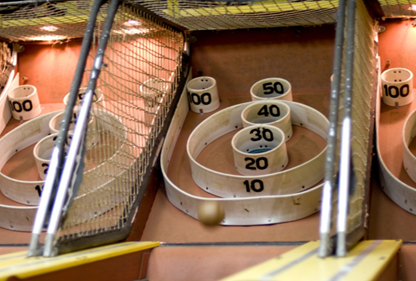
In ancient Rome, it was illegal to wear purple. Needless to say, that would not be a popular law in Sacramento Kings country. Times change, people change, and we expect the law to keep up.
And it usually does, except when it doesn’t. When you’re a city that’s more than a century old like Sacramento, a few oddities are bound to be lingering through inattention in the mustier pages of the city code.
So, out of curiosity, I decided to go spelunking to see just what I could find. Sacramento’s Municipal Code (SMC) did not disappoint. Here are the three most interesting artifacts I uncovered…
Comics Generally: No Laughing Matter

Pictured: Not a violation of SMC 9.12.010 … yet.
Kerpow! Bang! Zing! Many young boys and girls love reading superhero comics. Judging by box office receipts, the exploits of Marvel and DC’s caped crusaders are fairly mainstream American entertainment these days. I mean, who doesn’t like catching up on the latest of Spider-Man’s amazing adventures, or Wonder Woman’s derring-do, or Black Panther’s virtuous acrobatics?
Well… the City of Sacramento, apparently.
According to Sacramento Municipal Code (SMC) Section 9.12.010,
“It is unlawful for any person to distribute … for use by persons under the age of eighteen (18) years any … comic book … which depicts… the crimes of arson, assault with caustic chemicals, assault with a deadly weapon, burglary, kidnapping, torture, mayhem, murder, rape, robbery, theft or voluntary manslaughter.”
That’s right, in Sacramento it is illegal to sell (or even give) a minor any superhero crime-fighting comic book. So if Batman and Superman, in the comic pictured above, were to leave the basketball court for one second to stop a bank heist … verboten! The law was enacted in 1949 to, of course, protect “children of tender years.”
Interestingly, Sacramento was ahead of the curve on this moral panic: by the 1950s, concerns that comics were corrupting the youth would lead to bans across the country and ultimately prompted the industry to self-regulate by adopting the Orwellian Comics Code, which censored the storytelling of the next several generations of comic writers and illustrators.
So, next time you’re stopping by Oblivion Coffee & Comics or Big Brother Comics, just know that you have entered a wretched hive of scum and villainy that should probably have bouncers at the entrance.
Misplaced Expectations on Expectorating

Pictured: Gaston, upon reading SMC 9.04.040, probably.
Speaking of cartoons. Those of us who grew up in the 1990s, or raised children growing up in the 1990s, will remember Gaston, the cleft-chin villain of Disney’s Beauty and the Beast who is 90% pectoral muscles.
Girls: For there’s no one as burly and brawny…
Gaston: As you see I’ve got biceps to spare…
Lefou: Not a bit of him’s scraggly or scrawny…
Gaston: That’s right! And ev’ry last inch of me’s covered with hair!
Do you remember, though, his distinguishing talent that earned the admiration of the village ladies? He boasts, “I’m especially good at expectorating — Ptooey!” To which the crowd cheers, “Ten points for Gaston!”
Now, you may be thinking, expecto-what? Expectorating is a fancy way of saying “to spit.” And it’s illegal. So illegal.
That’s right. While Gaston’s ability to launch his saliva to great distances earned him the admiration of his peers in his “poor provincial town,” in Sacramento it would earn him a citation.
Specifically, SMC 9.04.040 provides that:
“No person shall expectorate … on any sidewalk in the city.”
This law, by the way, is ancient in city terms. I trace it at least as far back as 1896 in the city codes. (Necessary aside: demonstrating that Looney Tunes was really a PSA, another ordinance from that time, since repealed, prohibited throwing banana peels on the sidewalk!)
Spitting is of course unsightly, and might even be considered rude, but it seems pretty Victorian to prohibit what comes naturally to baseball players and 15 year-old boys. Obviously, Sacramento would not actually enforce this law.
Except that the City does! To my great surprise, from 2014 to 2016, the city issued five citations for expectorating. So, mind your Ps and Qs out there, and tell Gaston he’s probably better off staying in France.
Skee Ball: The Silent Killer

Pictured: Pure, Unregulated Chaos without SMC 5.48.010.
You may be thinking at this point that old-timey Sacramento, when most of these laws were passed, did not want people to have any fun. You are correct.
Okay, okay, so Sacramento isn’t quite the town that banned dancing in Footloose, but we do require a lot of special licensing for recreational activities that don’t seem to pose any special health or safety risk. For example, does your business have a coin-operated pool table? That’s a ($700!) license (SMC 5.20.010). How about four or more arcade video games? You better believe that’s a license (SMC 5.12.010).
Some of these decades-old licensing statutes are delightfully hyper-specific. For example, did you know that it is illegal in Sacramento, per SMC 5.16.010, to practice, without a license, “the business or art of astrology, palmistry, phrenology, fortune-telling, cartomancy, clairvoyance, clairaudience, crystal gazing, mediumship, prophecy, augury, seership, or necromancy”? So remember kids, when you want to pay someone to help you talk to the dead, make sure you insist upon a city-licensed necromancer. Because quality matters.
But my favorite license required by the City of Sacramento is for the privilege of operating a skee ball machine (and other “mechanical amusement devices”). Skee ball is the popular arcade game where you roll balls along a curved ramp and try and get them to land in rings assigned with different point values. You know the one.
What tickles me is not so much that you need a license to have a skee ball machine, which is admittedly pretty odd in itself, but the strict regulations that licensed skee ball machines must conform to. Behold. Under SMC 5.48.010, it is illegal, in Sacramento, for any skee ball machine:
- to give “the player, for actual play, only one ball;”
- to charge more than “twenty-five cents” per game; and, the kicker,
- to reward high-scoring players with “coupons or tickets.”
To review: one-ball skee ball? Illegal. Charging 50 cents for skee ball? Still illegal. Giving kids tickets for scoring 200+ points that they can turn in for erasers? Oh, most definitely illegal.
The Chuck E. Cheese animatronic rat is probably sweating right about now.
The skee ball law dates back to 1954; why it was needed, I’m not sure. But I choose to believe that a councilmember at the time visited a licensed crystal ball-gazer, who foretold of a dark future involving a dystopian children’s restaurant that enthralled the youth with ticket-spewing machines and singing giant animal cyborgs, and he said “not in my city, not on my watch.” (But, he failed, there’s a Chuck E. Cheese’s on Arden Way.)
The Lessons of Time
So, what to take away from all this? Well, first and foremost, don’t open that Old Sac Comics & Skee-Ball Fancy Arcade you’ve been dreaming of, the one with the period-appropriate sidewalk spittoons. Just a bad idea.
Second, City leaders might consider revising three sections of the Municipal Code…
But, third, we should all begin to think of policy obsolescence as a natural process and consider how to manage it. Sacramento is not unique in having some dated laws in its code. It could have been far worse. Just a few years ago, progressive-minded Oakland discovered that it still had a 131-year ban on cross-dressing on the city books.
The truth is that any city that’s more than a generation old is at risk of finding archaic, unhelpful, and/or deeply embarrassing laws in place. But even older laws that are not obviously out of step with the times deserve periodic revisiting, if only to ensure they are working.
One way to do this is to build studies and sunset dates into newly-enacted laws. This builds in a period of calm reflection, after whatever excitement caused the law to be enacted has passed. But, this approach is probably too administratively burdensome to put in place for every law; moreover, policy obsolescence often takes a generation or more, generally beyond any reasonable sunset date.
A more promising approach might be to mimic the state. California has a permanent Law Revision Commission whose mission is to review state statutes “for the purpose of discovering defects and anachronisms in the law and recommending needed reforms” to the Legislature. A local commission could take a deep dive into the SMC without the City Council itself having to devote inordinate time to the task. The city code is also much shorter than the state’s statute books, so a local commission might meet for just one out of every ten years. Some other California cities, like Roseville, have similar decennial commissions to study and suggest clean-ups to their city charter.
And just think, if we did set up a commission, it is entirely conceivable that kids could buy comic books in Sacramento by 2030!
– – – –
Skee ball image credit: Scott S

 Patrick Mulvaney
Patrick Mulvaney

 Isaac Gonzalez
Isaac Gonzalez

 California’s libraries collectively
California’s libraries collectively 




 Over the last several years, the conversation over who holds power in the upper echelons of the private sector and government have increasingly focused on the lack of women and people of color. Indeed, the University of California, Davis produced
Over the last several years, the conversation over who holds power in the upper echelons of the private sector and government have increasingly focused on the lack of women and people of color. Indeed, the University of California, Davis produced










 Sacramento makes a lot of fantastic beer! Just check out the lineup offered at my local Nugget (and thank them for offering a particularly good selection of local craft beers). While Sacramentality’s loyal readers will recall,
Sacramento makes a lot of fantastic beer! Just check out the lineup offered at my local Nugget (and thank them for offering a particularly good selection of local craft beers). While Sacramentality’s loyal readers will recall, 




 I’ve seen our local mid-sized breweries employ two primary strategies to significantly push past their tap room-generated demand.
I’ve seen our local mid-sized breweries employ two primary strategies to significantly push past their tap room-generated demand.













